
Fustian Mills
Fustian is a type of cloth that is believed to have originated in 2nd Century AD Egypt, at a place called Fustat. All different types of Fustian are constructed or cut in the same manner. A basic woven cloth had extra wefts sewn in as it was made, then the Fustian cutters would take a long sharp knife like instrument and walk the length of the cloth, cutting the extra wefts so that they formed a pile. Velveteen and corduroy were both made this way.
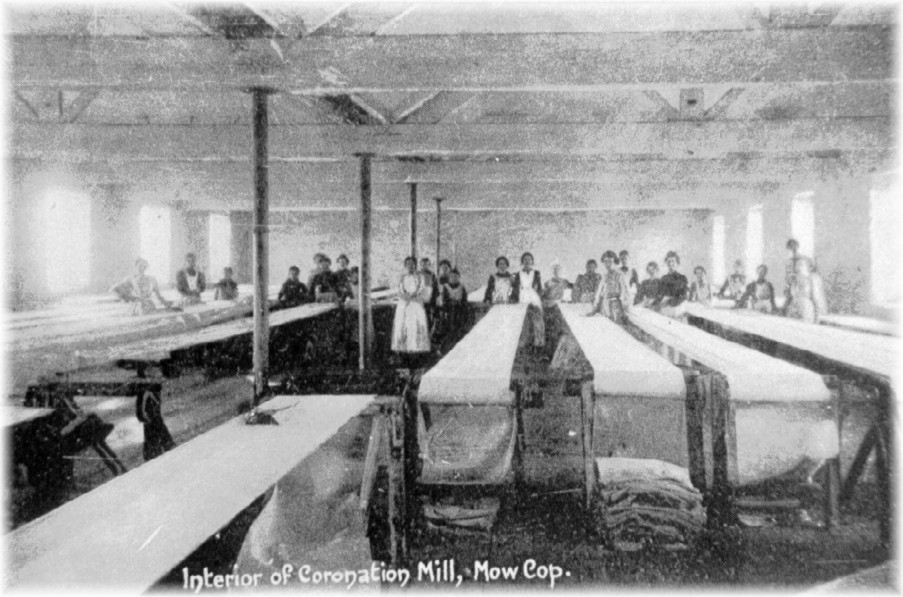
Towards the end of the 19th
century, velvet dealers, who were usually masters of the trade would set up
mills where they would employ many people to cut fustian for them. The Mills
were usually long dark places; the workers provided their own lighting and
would walk many miles in one day.
The roles of cloth from which the fustian was cut was usually 18 inches wide,
this was pulled tight over rollers and could stretch up to 150 yards long.
The workers would then walk the length of the cloth with their sharp pointed
cutting tool and cut open the wefts as they went. This would be similar to
opening a letter with a knife. This sounds simple, however, the best quality
fustian, like velveteen would need 40 cuts per inch. This means that a worker
would have to walk 72 miles in order to cut a pair of cloths, each one 145
yards long. If they made a mistake during the cut, they would be penalised,
like wise, if they left a cloth for someone else to finish this again would
lower the value. This is due to the fact that every individual held their
knife at different angles; this would result in slightly different piles.
Also a worker would loose money if they broke the knife, as they would have
to wait for a master to sharpen the tool, he in turn would probably be cutting
and would not want to stop, as he would be loosing money. The more you cut,
the more you were paid. Men had a slight advantage over the women in this
trade, firstly they could walk more miles per week, secondly, and many could
hold 2 knives at once, thus doubling their income.
There were many fustian mills built all up and down the country, Mow Cop itself could boast 3 The first and probably most unusual was the Coronation Mill, this is right at the top of Mow Cop hill and was used for cutting that we know of between 1902 when it was built and 1923. This Mill is a three- story building and is believed to be the site of what was the first Primitive Methodist Chapel on Mow Cop. The mill is still in use, however machines took over the work of fustian cutting in the 1940’s. The offices on the front of the present day Mill which was once a pub called the Odd Fellows Arms. This pub was built on the Staffordshire Cheshire border, due to different licensing laws, the drinker in the Cheshire side bar would have to go to the Staffordshire side bar at 10:30 on Sundays, whether this law was followed through however seems improbable. The mill has now being converted into luxury flats.
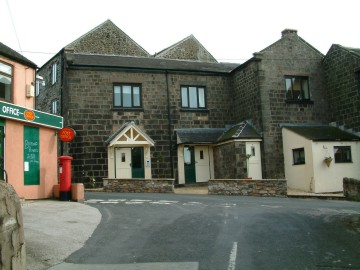
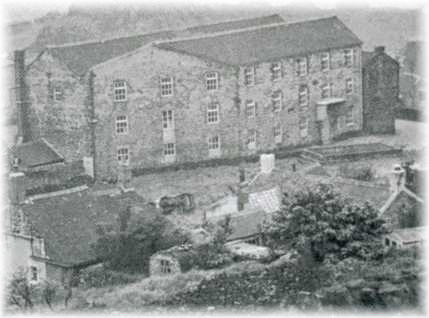
İRoger Hill 1967
This picture on the left taken from the
book
"The Old Man of Mow" (Collins press)
Shows a water tank just in front of the Mill, this would probably have been
used to hold the water for putting out fires.
When fustian was first cut, candles were used to provide the necessary lighting,
making fires a very common threat.
You can also clearly see the difference between the Mill and the Oddfellow
Arms.
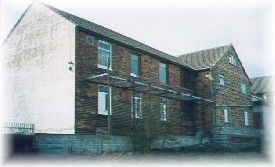 The
second is in fact two mills the Perseverance Mill and the Prospective Mill
(1890). The two from the air would form an L shape with Perseverance Mill
(1912)being mainly visible from the road (Church Lane). Prospective Mill pictured
here from behind runs parallel with Church Lane. Houses were built in front
of the mills for the workers in 1890. The design of Perseverance Mill enabled
it to be converted to houses in case the business failed. This mill continued
cutting up until 1940 and was operated by a Mr. George Shaw. Both mills are
owned by Des Ball who runs SRG packaging from Prospective while RDB Belting
runs from Perseverance Mill.
The
second is in fact two mills the Perseverance Mill and the Prospective Mill
(1890). The two from the air would form an L shape with Perseverance Mill
(1912)being mainly visible from the road (Church Lane). Prospective Mill pictured
here from behind runs parallel with Church Lane. Houses were built in front
of the mills for the workers in 1890. The design of Perseverance Mill enabled
it to be converted to houses in case the business failed. This mill continued
cutting up until 1940 and was operated by a Mr. George Shaw. Both mills are
owned by Des Ball who runs SRG packaging from Prospective while RDB Belting
runs from Perseverance Mill.
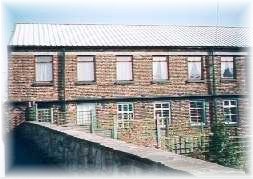
The third mill is Mount Pleasant Mill, another three story building, this mill was used up until the 1930’s and was last used for cutting by the United Velvet Cutters Association. This mill has now been turned into flats, again before this it was used by many trades including a caravan curtain center.
The Forgotten Mill
(By Audrey Chilton)
A few people may remember that there was once another Fustian mill at Bank. It was situated along Mill Lane, which branches off near the top of Spring Bank. I was born in 1932 at Bank Cottage and the Fustian mill was next door, but it was no longer in operation. Nearby was Darlington's farm with a duck pond in the yard. Somehow, this seemed to make the ground round our house and the Fustian rather marshy in places. We had a well in the cellar and water came out of a pipe at the side of the mill. This must have been an important factor in the siting of the premises. The front of the mill comprised two semi-detached dwellings, appropriately named Mill Cottages. I used to play a lot with the girls who lived in them, and recall that the rooms backing on to the mill were very long and dark with just a small window at the end.
At that time Bank House was the largest along Mill Lane. It boasted substantial outbuildings including a coach house. A lady called Miss Ford lived there. She was not at all sociable and we were afraid of her - perhaps needlessly! I believe she may have belonged to the family who owned the Fustian, as she was fairly well to do and had a car with a chauffeur who lived in an adjacent cottage. One of his daughters was another of my childhood friends.
On occasions we all used to play in the old Fustian mill. It was easy to get in and there was plenty of room to run about. We even had the convenience of "en suite" toilet facilities. There was an earth closet with a two-hole wooden seat and a generous supply of old newspapers that must have been there since "year dot." Probably the lavatory hadn't been emptied since then either, but we fearlessly made use of it when necessary.
I seem to remember things like old order books, catalogues and letters, which could have been quite informative to an industrial historian. As it was we were only interested in comics. Bank Fustian deteriorated rapidly as the floors went rotten and the windows were smashed. It became dangerous and was eventually knocked down, but Mill Cottages remained standing - and inhabited - for several more years. Just before the outbreak of the Second World War we moved from Bank Cottage to a newly built semi-detached house on Mount Pleasant Road, but I still went down to play with my friends along Mill Lane. I am not sure but think it may have been about 1950 before Mill Cottages were finally demolished to make way for some modern houses. I know that Bank House and Bank Cottage are still there. Darlington's pond has been filled in and the whole area is no longer as boggy.
Several houses have been built on Mill Lane since 1960, and it is hard to imagine that they stand on what was once an industrial site when Fustian cutting was in its heyday. Bank Fustian was smaller than its counterparts in Mount Pleasant and Mow Cop. It is interesting to speculate on when and why it was built there. Was it a pioneering business venture, or in rivalry with the other mills? Judging by its condition in the 1930s it would appear that once fustian cutting petered out, there had been no attempt to use the premises for any other manufacturing process. No one regretted its final demise. For years it had been an eyesore in an otherwise pleasant secluded rural retreat. In the end it was best forgotten.